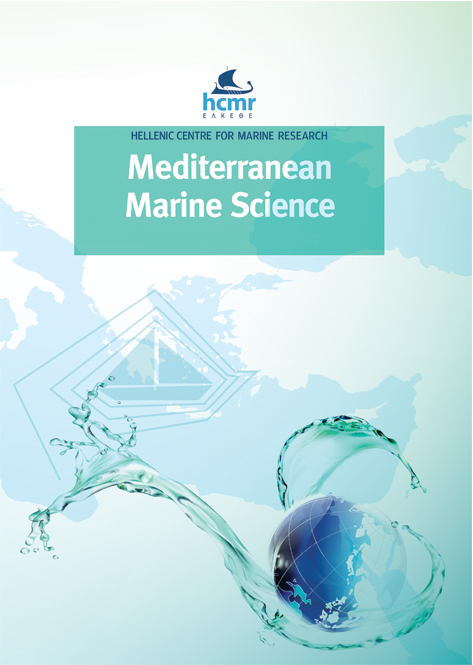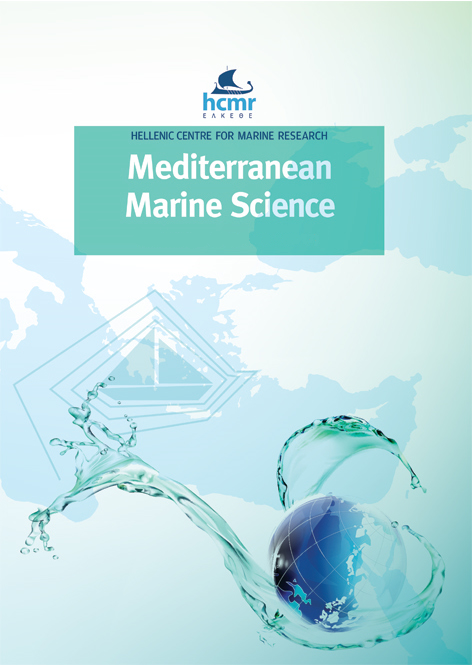Reproductive biology of Plesionika narval in the SE Aegean Sea (Eastern Mediterranean)
Περίληψη
Plesionika narval is a widespread species of the Pandalidae family, of particular high economic importance for small-scale shrimp trap fisheries in the Dodecanese Islands (SE Aegean Sea). Understanding its biology and reproduction are crucial for stock management. Reproductive biology aspects were studied through data collected during monthly experimental surveys with baited shrimps traps from November 2014 to October 2015 at a depth range of 10 - 150m. A total of 3436 individuals within the size range of 6.46 to 20.20 mm carapace length (CL) was analyzed. Overall, mean female size was significantly higher than mean male size, while the mean size of ovigerous females was higher than that of non-ovigerous females. Mean carapace length of ovigerous and non-ovigerous females was significantly correlated to depth. Ovigerous females were observed throughout the study period; however, monthly proportions revealed April to October as the main reproductive period of the species in the area. The sex ratio showed a clear predominance of females in the shallow depth zone (10-25 m) and was found to be affected by sampling area and depth zone. Immature females were found from November to March. Mature females were found all year round, exhibiting higher percentages in March, June, July and September, coinciding with the main reproductive period. P. narval seemed to spawn more than one time within the annual reproductive cycle. Gonadosomatic index obtained its highest mean values in May, June and September, thus revealing the main reproductive period. Size at first maturity for females was estimated at CL50=11.7 mm.
Λεπτομέρειες άρθρου
- Πώς να δημιουργήσετε Αναφορές
-
ANASTASOPOULOU, A., MAKANTASI, P., KAPIRIS, K., SMITH, C. J., MARAVELIAS, C., & KALOGIROU, S. (2018). Reproductive biology of Plesionika narval in the SE Aegean Sea (Eastern Mediterranean). Mediterranean Marine Science, 18(3), 454–467. https://doi.org/10.12681/mms.1944
- Τεύχος
- Τόμ. 18 Αρ. 3 (2017)
- Ενότητα
- Research Article
Authors who publish with this journal agree to the following terms:
- Authors retain copyright and grant the journal right of first publication with the work simultaneously licensed under a Creative Commons Attribution Non-Commercial License that allows others to share the work with an acknowledgement of the work's authorship and initial publication in this journal.
- Authors are able to enter into separate, additional contractual arrangements for the non-exclusive distribution of the journal's published version of the work (e.g. post it to an institutional repository or publish it in a book), with an acknowledgement of its initial publication in this journal.
- Authors are permitted and encouraged to post their work online (preferably in institutional repositories or on their website) prior to and during the submission process, as it can lead to productive exchanges, as well as earlier and greater citation of published work (See The Effect of Open Access).
Λήψεις
Αναφορές
Anastasopoulou, A., Makantasi, P., Kapiris, K., Smith, CJ., Maravelias, C., Kalogirou, S., 2015. Preliminary reproductive biology aspects of the narwal shrimp Plesionika narval in the Dodecanese Islands, SE Aegean Sea. International Congress on the Zoogeography and Ecology of Greece and adjacent Regions. 13th ICZEGAR, 7-11 October, Irakleio, Crete, Greece. Book of Abstracts, p.16 (http://13iczegar.nhmc.uoc.gr/programme).
Arculeo, M., Lo Brutto, S., 2011. Growth and reproduction data of Plesionika narval (Decapoda, Caridea, Pandalidae) off the Island of Ustica (Southern Tyrrhenian Sea). Crustaceana, 84(11),1367-1375.
Bauer, R.T., 1989. Continuous reproduction and episodic recruitment in nine shrimp species inhibiting a tropical seagrass meadow. Journal of Experimental Marine Biology and Ecology, 127, 175-187.
Biscoito, M.J., 1993. An account of the shrimps of the family Pandalidae (Crustacea, Decapoda, Caridea) in Madeiran waters. Courier Forschunginstitut Senckenberg, 159, 321-325.
Caldentey, M.A., Gonzales, J.A., Lozano, I.J., Santana, J.I., 1990. Aproximacion a la talla de primera madurez sexual depanda lidos en las Islas Canarias. Vieraea, 19, 201–208.
Carbonell, A., Abelló, P., 1998. Distribution characteristics of pandalid shrimps (Decapoda: Caridea: Pandalidae) along the western Mediterranean Sea. Journal of Natural History, 32, 1463-1474.
Carbonell, A., Palmer, M., Abelló, P., Torres, P., Alemany, R., Sola, L.G., 2003. Mesoscale geographical patterns in the distribution of pandalid shrimps Plesionika spp. in the western Mediterranean. Marine Ecology Progress Series, 247, 151-158.
Chilari, A., Thessalou-Legaki, M., Petrakis, G., 2005. Population Structure and Reproduction of the Deep-Water Shrimp Plesionika martia (Decapoda: Pandalidae) from the Eastern Ionian Sea. Journal of Crustacean Biology, 25(2), 233–24.
Christodoulou, M., Tzomos, T., Chartosia, N., Miltiadis-Spyridon, K., 2009. Decapod Crustaceans New To the Fauna of Cyprus. Marine Biodiversity Records, 2, 1-4.
Colloca, F., 2002. Life cycle of the deep-water pandalid shrimp Plesionika edwardsii (Decapoda, Caridea) in the Central Mediterranean Sea. Journal of Crustacean Biology, 22, 775-783.
Company, J.B., Sardà, F., 1997. Reproductive patterns and population characteristics in five deep-water pandalid shrimps in the Western Mediterranean along a depth gradient (150-1100 m). Marine Ecology Progress Series, 148, 49-58.
Crosnier, A., Forest, J., 1973. Les crevettes profondes de l’Atlantique Oriental Tropical. Faune Tropicale, 19, 1-409.
González, J.A., Tuset, V.M., Lozano, I.J., Santana, J.I, 1997. Biology of Plesionika narval (Crustacea, Decapoda, Pandalidae) around the Canary Islands (Eastern Central Atlantic). Estuarine, Coastal and Shelf Science, 44, 339-350.
Grant, A., Tyler, P.A., 1983. The analysis of data in studies of invertebrate reproduction. I: Introduction and statistical analysis of gonad indices and maturity indices. International Journal of Invertebrate Reproduction, 6(5-6), 259-269.
Heldt, H., Heldt, J.H., 1954. Les crustacés comestibles des mers tunisiennes et leur pêche. Annales. Station Océanographique de Salammbo, 9, 3-16.
Holthuis, L.B., 1980. FAO Species Catalogue. Vol. 1. Shrimps and Prawns of the World. An Annotated Catalogue of Species of Interest to Fisheries. FAO Fisheries Synopsis, 125 (Vol. 1), 271p.
Holthuis, L.B., 1987. Crevettes, p. 189-192. In: Fiches FAO d'identification des espèces pour les besoins de la pêche. Méditerranée et mer Noire. Zone de pêche 37. Vol. 1. Fischer W, Bauchot L and Schneider M (Eds.). Végétaux et Invertébrés, Rome.
Kalogirou, S., Anastasopoulou, A., Bordbar, L., Kapiris, K., Makantasi, P., Maravelias, C. D., Margaritis, M., Vasilakopoulos, P., Smith, C. J., 2016. Report of the Plesionika manage research pilot project. www.plesionika-manage.eu/en. Accessed 10 Sept 2016.
Kevrekidis, K., Galil, B.S., 2003. Decapoda and Stomatopoda (Crustacea) of Rodos island (Greece) and the Erythrean expansion NW of the Levantine sea (Mediterranean). Marine Science, 4(1), 57-66.
King, M., Butler, A.J, 1985. Relationship of life-history patterns to depth in deep-water caridean shrimps (Crustacea: Natantia). Marine Biology, 86, 129-138.
Kitsos, M.S., Tzomos, Th., Anagnostopoulou, L., Koukouras, A., 2008. Diet Composition of the Pandalid Shrimp, Plesionika narval (Fabricius, 1787) (Decapoda, Pandalidae) in the Aegean Sea. Crustaceana, 81, 23-33.
Koçak, C., Özbek, M., Tosunoğlu, Z., 2012. Aspects of biology of the deep-water pandalid shrimp Plesionika martia (A. Milne-Edwards, 1883) from Sığacık Bay (Eastern Mediterranean). Turkish Journal of Zoology, 36(2), 215-221.
Koukouras, A., Dounas, C., Turkay, M., Voultsiadou-Koukoura, E., 1992. Decapod crustacean fauna of the Aegean Sea: new information check-list. Affinities. Senckenbergiana maritime, 22, 217–244.
Koukouras, A., Kallianiotis, A., Vafidis, D., 1998. The decapod crustacean genera
Plesionika Bate (Natantia) and Munida Leach (Anomura) in the Aegean Sea. Crustaceana, 71, 714–720.
Li, X., 2006. An account of the pandaloid shrimps (Crustacea: Decapoda: Caridea) in the collections of the Quensland Museum. Memoires of the Quensland Museum, 52(1), 151-170.
Lucifora, L. O., Valero, L., Garcia, V. B., 1999. Length at maturity of the greeneye spurdog shark, Squalus mitsukuii (Elasmobranchii: Squalidae) from the SW Atlanic, with comparisons with other regions. Marine and Freshwater Research, 50, 629-632.
Maiorano, P., D’Onghia, D. G., Capezzuto, F., Sion, L., 2002. Life-history traits of Plesionika martia (Decapoda: Caridea) from the eastern-central Mediterranean Sea. Marine Biology, 141, 527–539.
Martins, H. R., Hargreaves, P. M., 1991. Shrimps of the families Pandalidae and Hippolytidae (Crustacea: Decapoda) caught in benthic traps off Azores. Arqipelago, 9, 47-61.
Possenti, E., Sartor, P., Ranieri, S.D., 2007. Reproductive biology of females of Plesionika edwardsii (Brandt, 1851) (Crustacea, Decapoda, Pandalidae) in the northern Tyrrhenian Sea (western Mediterranean). Atti della Societa Toscana di Scienze Naturali - Memorie serie B, 114, 91-98.
Santana, J. I, Gonzales, JA. A., Lozano, I. J,, Tuset, V. M., 1997. Life history of Plesionika edwardsii (Crustacea, Decapoda, Pandalidae) around the Canary Islands, Eastern Central Atlantic. South African Journal of Marine Science, 18, 39-48.
Sousa, R., Henriques, P., Biscoito, M., Pinto, A. R, Delgado, J., Dellinger, T., Gouveia, L., Rinho, M. R., 2014. Considerations on the Biology of Plesionika narval (Fabricius, 1787) in the Northeastern Atlantic. Turkish Journal of Fisheries and Aquatic Sciences. 14. 727- 737.
Strum. LM. G., 1978. Aspects of the biology of Scombemorus maculatus (Mitchill) in Trinidad. Journal of Fish Biology, 13,155-172.
Thessalou-Legaki, M., 1992. Reproductive variability of Parapandalus narval (Crustacea: Decapoda) along a depth gradient. Estuarine, Coastal and Shelf Science, 35, 593-603.
Thessalou-Legaki, M., Frantzis, A., Nassiokas, K., Hatzinikolaou, S., 1989. Depth zonation in a Parapandalus narval (Crustacea, Decapoda, Pandalidae) population from Rhodos Island, Greece. Estuarine, Coastal and Shelf Science, 29, 273-284.
Zar, J. H., 1984. Biostatistical analysis (3rd edition). Englewood Cliffs, N.J.: Prentice Hall International Editions. N.J. 662 pp.
Zariquiey Alvarez, R., 1968. Crustáceos Decápodos Ibéricos. Investigaciaón Pesquera, 32, 1-510.








